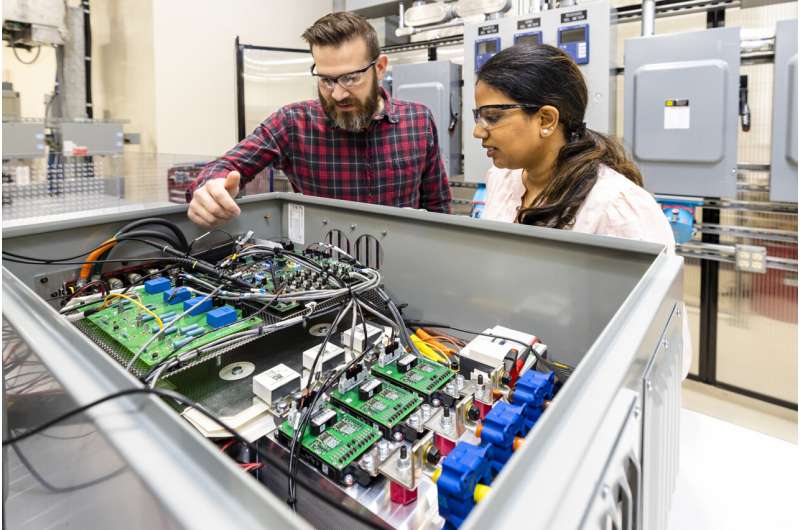This article has been reviewed according to Science X's editorial process and policies. Editors have highlighted the following attributes while ensuring the content's credibility:
fact-checked
trusted source
proofread
SUPER technology manages intelligent building blocks for a more reliable electric grid

Researchers at the Department of Energy's Oak Ridge National Laboratory are helping modernize power management and enhance reliability in an increasingly complex electric grid.
As the United States transitions to cleaner energy and more U.S. consumers adopt electric vehicles, the grid is facing new power flow demands. ORNL researchers are tackling this challenge by creating a new architecture to modernize the grid from the bottom up, starting with consumers and expanding to the entire power distribution system. A cornerstone of this architecture is a new power electronics technology suite called a Smart Universal Power Electronics Regulator, or SUPER.
The approach combines hardware and software to monitor equipment health, speed up communication and increase security. In the long run, that means fewer and shorter blackouts for customers, savings for utilities and a more reliable grid.
SUPER is a type of power converter consisting of "stackable" power electronics building blocks with enhanced abilities and intelligence. Just as the building blocks can be stacked within the SUPER system, the SUPER systems can also be stacked to make a data center, microgrid or electrical substation. To be universal, SUPER is designed with standardized interconnections and communication protocols, easing system integration for a wide range of applications.
Madhu Chinthavali, head of ORNL's energy systems integration and controls section, said this architecture can help manage clean energy both where it is generated and when it is transferred elsewhere through power lines. Today, that requires many pieces of equipment, which multiply grid connections, clutter grid communications and increase vulnerability to cyberattacks and electricity loss. SUPER can act as the gatekeeper between the grid and each power source or electrical load.
"The management of energy transfer is a big challenge, and ORNL is trying to build a structured partnership to accelerate the development of these concepts and potentially demonstrate them in the near term," Chinthavali said. ORNL has helped organize the Power electronics Accelerator Consortium for Electrification, or PACE, to quickly take innovations like SUPER to utilities and manufacturers.
Although blocks of power electronics have been stacked to create a converter or substation before, their capabilities are limited by simplistic controls and communication. "With existing technology, if one chip fails, the whole converter fails," said ORNL lead researcher Radha Krishna Moorthy. "And you can only replace it with parts from the original manufacturer, because the components will only work with equipment from the same company." That increases costs and delays, said Steven Campbell, a technical lead on the lab's project.
To address these challenges, ORNL researchers are working with seven university partners to create interchangeable building blocks called intelligent power stages that can be managed by the controller in SUPER. "Essentially its controller acts as the brain, and its intelligent power stage is the heart of the technology," Campbell said.
The intelligent power stage, or IPS, can be removed or replaced without shutting down the system, Krishna Moorthy said. Compared with existing technology, an IPS has more sensors and computational ability, enabling it to monitor its components and detect problems sooner.
"Traditional systems can give you some sensor data about voltage and current, but SUPER gives you more information to make good decisions," Krishna Moorthy said. "If you always have health data, you can schedule maintenance ahead of time and minimize downtime, which increases the health of the electric grid."

















